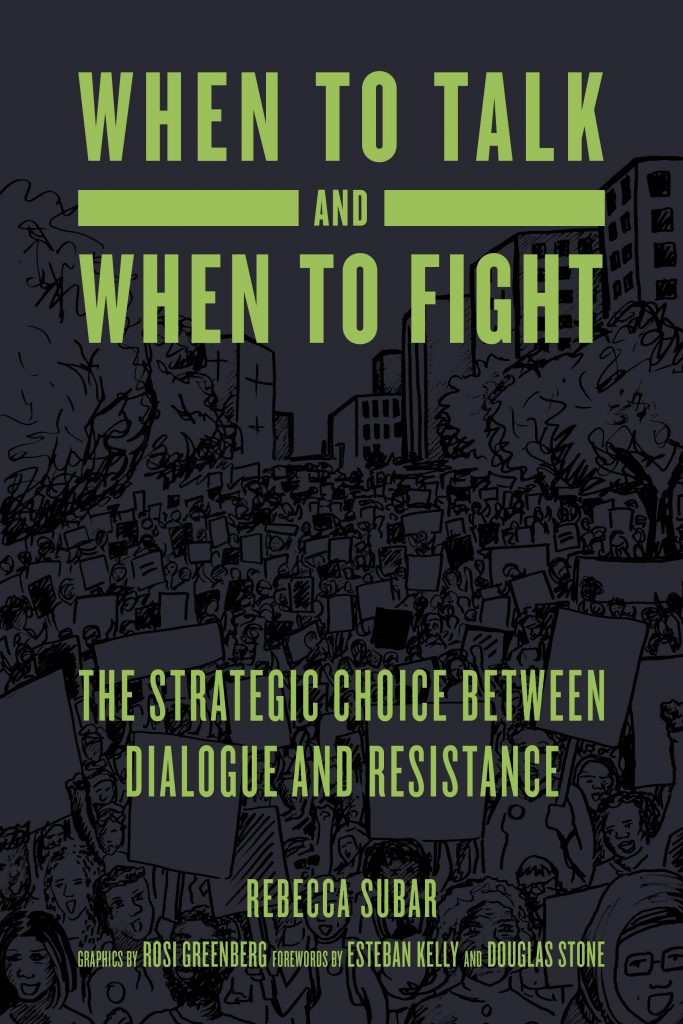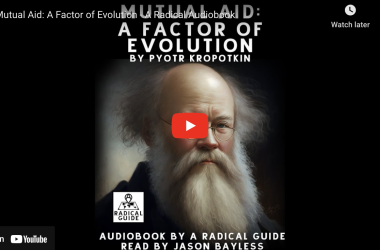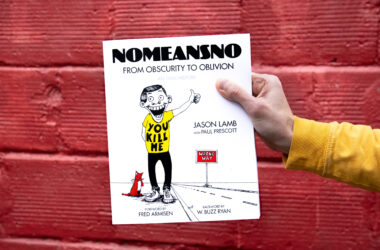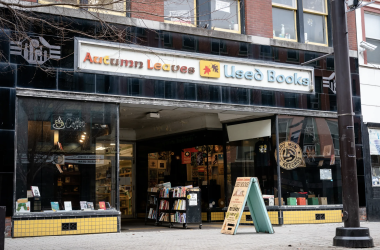Because there is a difference and it matters
By James Munn
September 22nd, 2021
Community organizers love the fight. Battle scars are worn with pride, and our identities as fighters are forged with care. The stories we tell each other at the bar or across the campfire brim with extraordinary tension and conflict with our opponents. These are the incandescent moments of struggle that define our lives.
We love nothing more than a well-executed, non-violent direct action that breaches an opponent’s defenses, overcoming all odds (at least in the story) as we charge uphill to win something big that gets at the root causes of structural oppression and inequality. Moments like these light a fire in our bellies, then keep our cold, creative anger about injustice at a simmer. They are what keep us going.
Yeah, fighting is great. Except when it’s not the way to win. And it’s not, always. There are times when dialogue is far more effective. This is a hard lesson for organizers to absorb, and even harder for us to put into practice, when we spend most of our lives girding for battle.
That’s why Rebecca Subar’s When to Talk and When To Fight: The Strategic Choice Between Dialogue and Resistance is an essential addition to every organizer’s bookshelf. Her writing is crisp and jam-packed with insights that can help us effectively evaluate conflicts and apply the right tool for the job.
Subar notes early on that this book is for “people who are drawn to moments of conflict — to struggles, campaigns, and fights at work and in our communities. It is about these moments of choice, whether your inclination is to fight and win or to find resolution without destroying relationships or ruining lives.”
Yet she quickly cautions that “When a group picks one method — dialogue or resistance — and sticks with it, its members lose the ability to build power and get what they want.”
Subar offers a framework for how to make the most strategic choice between conflict and dialogue, and identifies four factors that should inform each choice: “the power dynamics of the conflict, the structural obstacles in the way of certain course of action, the principles and values to which groups are committed, and the biases and tendencies that prevent them from choosing an approach based on power and principle.”
Subar further organizes her framework into three columns:
Methods of dialogue, negotiation, and talking are lined up in Column A, and methods of resistance, protest, and fighting are lined up in Column B.
While Column A methods are consensual, the methods in Column B are chosen and enacted unilaterally by one party to the conflict against another (or others).
Power is built in Column B and embodied in Column A.
Groups move from Column A to Column B as necessary to build power, and from Column B back to Column A when power is sufficiently equalized to facilitate an acceptable negotiation outcome.
Vanquishing is a fight to the end. It is about besting the opponent until they are powerless to prevail. Vanquishing, whether it is wielded by those in power or by those with less power, is the realm of Column C.
In short, power is built in Column B and Column C, and conflicts are resolved in Column A and Column C.
Groups that can artfully “dance” between Columns A and B to build power and exercise it will be more successful than those committed to one or the other. The truly excellent flowchart game in When to Talk and When to Fight maps all of this out so clearly you can see the butcher paper on the walls and smell the markers.
Good strategists know that if they want to win they must map out their campaigns several moves in advance. Why? We can’t play checkers when the other side is playing chess, so every campaign conducts a power analysis of opponents in order to map out the pacing and sequencing of moves from the opening to the endgame. Yet few strategists bring the level of insight and rigor that Subar demands.
Subar encourages groups to examine four aspects of themselves before making decisions about strategy. She urges us toward patient, self-aware work that goes a long way to building a winning campaign. Subar explains:
It is about power — weaker groups mobilizing power to match the structural, economic, or military power of the decision makers. It is about structural barriers — formidable obstacles that can get in the way of a group’s chosen strategy. It is about principle — groups filtering their strategic choices through their values. And it is about biases — the inclinations and influences that unwittingly cause groups to circumvent effective, available, principled strategy in favor of familiar, comfortable, reassuring, unexamined strategy.
Subar is careful to examine how structural barriers like “money, sexism, and other entrenched social, political, and cultural realities” can limit the choices of groups. This is real for individuals who experience structural oppression and for organizations navigating structural barriers in campaigns. We cannot ignore these barriers, as doing so warps our view of reality and leads to less effective strategy and choices, but neither can we accept their limitations when we are building toward an equitable vision of the world. Subar takes this a step further by giving “a name to the phenomenon of uprank groups failing to perceive the power dynamics that downrank groups experience and understand: “know-and-tell.” Downrank groups perceive the workings of power more acutely than do uprank groups.” This means that people with less structural barriers need to work hard to see their biases more clearly, and they need to trust that “downrank” people who face more structural barriers can see the reality of power relations more clearly.
The final additions to Subar’s lexicon of conflict are three categories that compose the currencies of power: structural power, resources on hand, and potential power. As an organizer, I have come to see the sources of power as organized people, money and ideas, with ideas being a living accumulation of previously organized people and money. So I share Subar’s understanding that structural power is, “the positional power of elected office or the way money is distributed in this country.” In other words, it is power that has been won by one side already.
Subar describes resources on hand in the same way I would describe organized power: “networks, knowledge, and cash.” Potential power is something more universally understood — it’s the people and money available to us to organize.
In the gorgeously written coda to When to Talk and When to Fight, Subar closes by reminding us that “wise groups, like each of us at our wisest, play this tug of war with skill and love.”
The strategic choice between talking and fighting that Subar proposes comes to life in Katharine Hayhoe’s Saving Us: A Climate Scientist’s Case for Hope and Healing in a Divided World. Hayhoe helps us learn how to have real conversations about climate change with people we might otherwise choose to fight. She unites a scientist’s rigor with a Christian grounding in love to move people toward climate solutions with the deepest care.
Hayhoe shares her own, real-life version of Subar’s ABC framework: she’s a climate scientist and academic who lives in oil-rich Lubbock, Texas, and a sincere Christian. While Saving Us makes the case for how and why the climate is changing, Hayhoe keeps a clear focus on how to build our potential power through conversations about climate with everyone who will listen. This means never leaving power on the table and not self-limiting our power by only preaching to the converted.
Hayhoe explains “how after thousands of conversations, I’m convinced that the single most important thing that anyone — not just me, but literally anyone — can do is to bring people together is, ironically, the very thing we fear most. Talk about it.”
Subar makes the point that unless we check our biases we may be making strategic errors, and Hayhoe takes this further. You might think that the other side disagrees with you more than you think, and therefore you don’t engage with them at all. In fact, there are not two sides to the debate, but six — what the Yale Program on Climate Change Communication’s Global Warming’s Six Americas calls the Alarmed, Concerned, Cautious, Disengaged, Doubtful, and Dismissive. This means that there is a supermajority of potential power on the table, something we ignore at our own peril.
Hayhoe brings a scientist’s appreciation for the simplest solution to complex problems as she encourages us to stop reacting to things you don’t agree with and start having conversations about things you agree on. She continues, “What if you asked questions rather than arguing? What if you shared, genuinely and personally, how climate change threatens what you care about? And what if you talked about practical, real-world solutions that are already available today?”
Saving Us has a model for just this kind of conversation. It’s simple, like a one-on-one meeting, with the real work being vulnerability, honesty, and real human connection:
Start with something you have in common.
Then, describe what people can and are doing to fix it.
By bonding over the values we truly share, and by connecting them to climate, we can inspire one another to act together to fix this problem.
What I love about Hayhoe’s book is how it reminds us to clarify our own self-interest before exploring other people’s. She goes step-by-step through the major pieces of self-interest just as organizers do, and asks people to inventory their stories, values and beliefs in each. She takes a chapter to go through areas such as where I live, what I love doing, where I’m from, those I love, and what I believe. Then it’s just about being really genuine.
Having a conversation about climate change based on self-interest sidesteps both the overwhelming nature of the problem and partisan takes on the solution. It’s not the degree of Celsius change that is causing us to panic, Hayhoe reminds us. She says “we care because the cascade of events triggered by that warming affects everything we already care about: where we get the food we eat and how much it costs; how clean or dirty the air we breathe is; the economy and national security; hunger, disease, and poverty across the planet; the future of civilization as we know it.” Ripe conversational fodder indeed!
Once we’ve established a relationship and conversation, we can get into the implications from Hayhoe’s own research about “the way rising temperatures will inflict damage on the systems that sustain our lives — water, food, infrastructure, health — so that we can make wise decisions now.” She continues to describe how in this way climate change is a human issue with “a simple yet potentially revolutionary realization: getting people to care about a changing climate doesn’t require them to adopt “new” values.” We’re not telling people they are bad or wrong in ways that immediately attack their identity. Like good organizers, we are helping them clarify their own self-interest and convince themselves that they care about climate change because of what their values tell them they already care about.
We can and should acknowledge, as Hayhoe does, that “while electricity is a moral necessity — fossil fuels aren’t.” What we need is energy. Fossil fuels replaced human energy — slavery, indentured servitude, and the brutal oppression of women, Indigenous Peoples, and people of color to provide the energy for the rise of civilization as we know it. But energy itself is, according to Hayhoe, “one of the primary ways that we can address and tackle poverty, lack of access to clean water and sufficient food, among other development goals. But today, for the first time in hundreds of years, fossil fuels don’t have to be the source of it.”
Outside of people who question the science or causes of climate change, the barrier among the Alarmed and Concerned is knowing what to do. Hayhoe discusses the work of Stanford psychologist Albert Bandura, who proposed and proved that people change their behavior if they feel personal efficacy. She says that studies in the U.S. and elsewhere show that people’s sense of efficacy when it comes to climate change is generally low.
So while we talk to people, we have to help them find a sense of personal and collective efficacy. Otherwise we’re just admiring the problem, and from there we’re headed to depression, inaction, and shame. Hayhoe cites the work of psychologist Rubin Khoddan who points out: “we humans constantly fall victim to the motivation trap, waiting until we feel like it until we act. In fact, he says, “valued action,” meaning action that is consistent with your values, “comes first,” and motivation follows.” Action transforms people, and I love the strategic offering here that moving people into action quickly is a way for them to find their personal and collective efficacy faster than trying to develop it in the abstract.
Which leads us to Hayhoe’s climate change conversation model, one I am looking forward to trying out with friends and family. She begins by reiterating that “the most important thing every single one of us can do about climate change is talk about it — why it matters, and how we can fix it — and use our voices to advocate for change within our spheres of influence.”
We don’t need more experts or memes to move people on climate. We need you, Hayhoe tells us. “Yes, you,” she continues, “Someone who understands why this issue matters, who shares the same values, who cares about them — you are the perfect person to have this conversation with the people in your life.”
So if you thought the solution to climate change is some magical, techno-capitalist solution, this scientist tells us, think again. You, me, and the rest of us are who we are waiting for (thank you June Jordan!).
Hayhoe explains how “connecting with people over genuinely shared values reaches directly into our hearts, past the barriers of “them” and “us” that we’ve erected, to identify with one another over something that matters to us deeply and defines who we are. That makes it the perfect place to start the conversation.”
Ready for the secret formula? Hayhoe proposes this: bond, connect, and inspire. Step one: find one or two people who are not totally Dismissive. Reflect on what you have in common: a value, an activity, some part of your life. Step two is to prepare. Know what you are going to share about the impacts of climate change on your life, and be prepared to ask about theirs.
Connect on your everyday lives, not theory or numbers. Don’t get discouraged. Hayhoe says that your goal is to simply open the door, not convert them to a new religion. Third step is to listen. Like a one-on-one meeting, listen at least 70 percent of the time. Finally, learn from every conversation.
Hayhoe concludes with hope and science, knowing that “it is not too late to avoid the most serious and dangerous impacts, and our choices will determine what happens. Our future is in our hands and we cannot afford to be paralyzed by fear and shame. We must act, with power, love, and a sound mind, so we can fix climate change before it fixes us…The first step across the abyss we all face together is to recognize we are not alone. Together, we are the answer to climate change — and building that bridge begins with a conversation, today.”
If you’re like me, there’s something you love more than fighting: the people in the fight. I wish I had read authors like Subar and Hayhoe far earlier in my life as an organizer. They would have saved me a mountain of trouble. More than once, I have chosen to fight when I should have chosen to talk, and paid the price.
As organizers, we learn how to see through power relations with x-ray vision, inspire people to let go of fears that hold them back from greatness in public life, forge relationships that reveal and revel in our shared humanity, and form leagues of justice. That is what organizing is really about. Subar and Hayhoe offer ways to do all of this better. They are intentional about relationships in ways that will be familiar to skillful organizers, but they add a layer of analysis that will make us more effective. The abundant care that both Subar and Hayhoe express in their approach to each person and group is the bright through line between their books. Their frameworks and languages add nuance and depth to approaching conflict in concrete ways, but it’s the love and intention that make them go so well together.
BOOKS REVIEWED:
Subar, Rebecca. When to Talk and When to Fight: The Strategic Choice Between Dialogue and Resistance. PM Press, 2021.
Hayhoe, Katharine. Saving Us: A Climate Scientist’s Case for Hope and Healing in a Divided World. Altria/One Signal Publishers, 2021.
First published in Social Policy: Organizing for Social & Economic Justice. Fall 2021, Vol. 51, #3.







